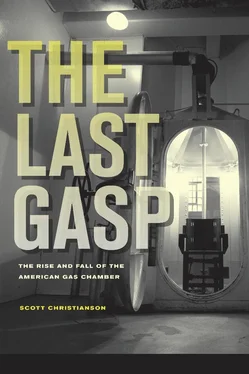Eugenics rapidly caught on all over the Western world, including the United States. America had only recently ended its practice of slavery, and it continued to treat blacks as second-class citizens. It was also still cleaning up from its policies of genocide, relocation, imprisonment, and ethnic cleansing directed against the Native Americans. Eugenics dovetailed readily with other already established American notions such as manifest destiny, racial segregation, and a reliance on capital punishment.
Max Weber characterized the modern state as monopolizing the means of legitimate physical violence in the enforcement of its order. Coincidentally, discussions in the United States regarding eugenics, euthanasia, and the lethal chamber occurred just as the modern state was taking over the execution process from local powers that heretofore had entrusted their hangings to lynch mobs or the local sheriff. 13Prior to 1900, lynching was more common than official execution as the predominant mode of the death penalty in the United States, claiming more lives over the course of American history than legal capital punishment. Of 3,224 Americans lynched between 1889 and 1918, 702 were white and 2,522 were black; many of those killed were strung up for such crimes as talking boldly to a white man or eyeing a white girl, and all of them were killed without the benefit of due process. 14During the same period, 1,080 convicted defendants were officially put to death under state authority, of which slightly fewer than half were white. 15
In New York, one way that the consolidation of state power was manifested involved a sweeping change in the entire manner of official executions. In 1885 a new governor, David B. Hill, rode into office, saying, “The present mode of executing criminals by hanging has come down to us from the dark age and it may well be questioned whether the science of the present day cannot provide a means for taking the life of such as are condemned to die in a less barbarous manner.” 16Determined to find a better method of execution, he appointed to study the matter a blue-ribbon commission consisting of a prominent lawyer, a physician, and a descendant of one of the signers of the Declaration of Independence who was counsel to the Society for the Prevention of Cruelty to Animals. The commission circulated a questionnaire asking respondents if they favored a substitute to hanging, and added that the following options had been proposed: 1) electricity; 2) Prussic acid (also known as hydrogen cyanide, hydrocyanic acid, or HCN) or other poison; 3) the guillotine; 4) the garrote. For further assistance the commission called on the New York Medico-Legal Society, an influential body of medical and legal experts involved in shaping medical jurisprudence. In 1878 the society had hosted a lecture by Professor J. H. Packard of Philadelphia, who recommended that hanging be replaced by the most painless method available, which he claimed was sulfuric oxide gas, administered by means of the lethal chamber. 17(Sulfuric dioxide was the gas Napoleon’s army allegedly used to murder captive slaves in Haiti.)
As the commission went about its task, Dr. J. Mount Bleyer, a New York physician and self-proclaimed opponent of the death penalty, emerged as one of the New York Medico-Legal Society’s most energetic advocates of chemical execution. Bleyer carefully assessed a number of never-before-administered alternatives to hanging, including lethal injection, electrocution, and the lethal chamber, but his proposal that a hypodermic needle might be used to inject a fatal dose of morphine did not go over well with other members of the medical community. The notion of utilizing an electrical device received much more favorable reception, in part because it was viewed as a more powerful deterrent to crime. He also proposed that a large dose of chloroform might be held over the condemned prisoner’s mouth and nostrils, but this, too, was rejected because it was considered to seem like a mercy killing or euthanasia rather than capital punishment. Besides, it might prove difficult to administer to a struggling convict, and also, to be effective it would require that the execution be carried out on an empty stomach, and some thought this violated the time-honored custom of allowing the condemned to enjoy a last meal of his choice. 18
In addition to Bleyer, other members of the medical community also weighed in. One of these was Allan McLane Hamilton, M.D., a prominent alienist and forensic specialist and a direct descendant (and biographer) of Alexander Hamilton whose work treating nervous diseases had led him to experiment with a number of innovative approaches, including electro-therapeutics and the use of nitrous oxide. Hamilton, who had also studied criminals’ brains and attended numerous executions and autopsies, favored the lethal chamber. He proposed sentencing a prisoner to be put to death during a certain week, without specifying the precise date. Unbeknownst to the condemned, the condemned prisoner’s cell would be “hermetically sealed” and fitted with pipes leading to a furnace or engine. Carbon dioxide or carbon monoxide could then be pumped in while he was asleep. The unsuspecting convict would never awaken, thereby being spared the fear and pain of an ordinary execution. The witnesses would also avoid the usual distasteful public spectacle, and yet justice would be done. 19
One New Yorker who liked Hamilton’s idea of using lethal gas instead of electrocution was J. Sloat Fassett, a Republican state senator from Elmira who had studied at the University of Heidelberg in Germany (and who later would serve as a congressman and secretary of the Republican National Committee). 20Fassett was among those who favored gas execution. But Hamilton’s idea didn’t catch on initially, in part because not everyone was convinced that gas technology was up to the task yet. As a result, the commission rejected the proposal for the lethal chamber in favor of electrocution, although the place in the prison where the executions were carried out came to be called the “death chamber” rather than the gallows. 21
New York wasn’t the only state to consider gas executions. In 1886 the Medical Society of Allegheny County, Pennsylvania, completed its own study of death-penalty methods by concluding that the “most humane method is to extinguish the life of the criminal sentenced to death by the use of gas.” It contended that “the gas chamber will be at once more effective, cheaper, and less repugnant to the gentler sentiments than the electric chair.” 22Henry M. Boies, a penologist for the Pennsylvania Board of Public Charities, went further by saying that it was “established beyond controversy that criminals and paupers, both, are degenerate; the imperfect, knotty, knurly, worm-eaten, half-rotten fruit of the race.” Society, he said, needed to take a multifaceted approach that included preventive and reformative measures. In his view, “The ‘unfit,’ the abnormals, the sharks, the devil-fish, and other monsters, ought not to be liberated to destroy, and multiply, but must be confined and secluded until they are exterminated.” 23
Such calls were taken seriously, and some sought to make them a reality. In 1899 W. Duncan McKim, a prominent New York physician and eugenics advocate, argued, “The surest, the simplest, the kindest, and most humane means for preventing reproduction among those whom we deem unworthy of this high privilege [of human reproduction], is a gentle, painless death.” McKim aimed his plan at “the very weak and the very vicious, who fall into the hands of the State, for maintenance, reformation, or punishment ”—idiots, imbeciles, most epileptics, insane or incorrigible criminals, and a few other classes. To eliminate them, he recommended the use of carbonic acid gas (also known as carbon dioxide, the gas that had been widely used to euthanize animals). 24At the time, McKim’s view was widely shared in the United States; The Nation magazine of November 1, 1900, recommended his work to “all good citizens interested in human progress.” But still, gas executions remained just an idea whose time hadn’t come.
Читать дальше












